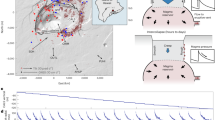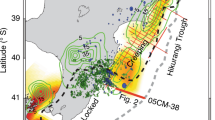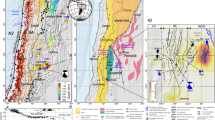Abstract
Various studies report on temporal changes of seismic velocities in the crust and attempt to relate the observations to changes of stress and material properties around faults. Although there are growing numbers of observations on coseismic velocity reductions, generally there is a lack of detailed observations of the healing phases. Here we report on a pronounced coseismic reduction of velocities around two locked sections (asperities) of the Longmenshan fault with a large slip during the 2008 Mw 7.9 Wenchuan earthquake and subsequent healing of the velocities. The healing phase accelerated significantly at the southern asperity right after the nearby 2013 Mw 6.6 Lushan earthquake. The results were obtained by joint inversions of travel time data at four different periods across the Wenchuan and Lushan earthquakes. The rapid acceleration of healing in response to the Lushan earthquake provides unique evidence for the high sensitivity of seismic velocities to stress changes. We suggest that stress redistribution plays an important role in rebuilding fault strength.
This is a preview of subscription content, access via your institution
Access options
Access Nature and 54 other Nature Portfolio journals
Get Nature+, our best-value online-access subscription
$29.99 / 30 days
cancel any time
Subscribe to this journal
Receive 12 print issues and online access
$259.00 per year
only $21.58 per issue
Buy this article
- Purchase on Springer Link
- Instant access to full article PDF
Prices may be subject to local taxes which are calculated during checkout




Similar content being viewed by others
Data availability
The travel time data are provided by the Sichuan Earthquake Administration and the China Earthquake Data Centre and are available at http://data.earthquake.cn/.
Code availability
The codes used to generate individual results are available through the contact information from the original publications. Requests for further materials should be directed to S.P. (peisp@itpcas.ac.cn).
Change history
17 June 2019
An amendment to this paper has been published and can be accessed via a link at the top of the paper.
References
Niu, F., Silver, P. G., Nadeau, R. M. & McEvilly, T. V. Migration of seismic scatterers associated with the 1993 Parkfield aseismic transient event. Nature 426, 544–548 (2003).
Schaff, D. P. & Beroza, G. C. Coseismic and postseismic velocity changes measured by repeating earthquakes. J. Geophys. Res. 109, B10302 (2004).
Peng, Z. & Ben-Zion, Y. Temporal changes of shallow seismic velocity around the Karadere–Duzce branch of the North Anatolian fault and strong ground motion. Pure Appl. Geophys. 163, 567–599 (2006).
Niu, F., Silver, P. G., Daley, T. M., Cheng, X. & Majer, E. L. Preseismic velocity changes observed from active source monitoring at the Parkfield SAFOD drill site. Nature 454, 204–208 (2008).
Brenguier, F. et al. Postseismic relaxation along the San Andreas fault at Parkfield from continuous seismological observations. Science 321, 1478–1481 (2008).
Wu, C. Q., Peng, Z. G. & Ben-Zion, Y. Non-linearity and temporal changes of fault zone site response associated with strong ground motion. Geophys. J. Int. 176, 265–278 (2009).
Bonilla, L. F., Guéguen, P. & Ben-Zion, Y. Monitoring co-seismic temporal changes of shallow material during strong ground motion with interferometry and autocorrelation. Bull. Seism. Soc. Am. 109, 187–198 (2019).
Cheng, X., Niu, F. & Wang, B. S. Coseismic velocity change in the rupture zone of the 2008 M w 7.9 Wenchuan Earthquake observed from ambient seismic noise. Bull. Seismol. Soc. Am. 100, 2539–2550 (2010).
Froment, B. M., Campillo, M., Chen, J. H. & Liu, Q. Y. Deformation at depth associated with the 12 May 2008 M w 7.9 Wenchuan earthquake from seismic ambient noise monitoring. Geophys. Res. Lett. 40, 78–82 (2013).
Obermann, A. et al. Seismic noise correlations to image structural and mechanical changes associated with the M w 7.9 2008 Wenchuan earthquake. J. Geophys. Res. 119, 3155–3168 (2014).
Lay, T. & Kanamori, H. Insights from the great 2011 Japan earthquake. Phys. Today 64, 33–39 (2011).
Murray, J. R. & Segall, P. Spatiotemporal evolution of a transient slip event on the San Andreas fault near Parkfield, California. J. Geophys. Res. 110, B09407 (2005).
Obara, K. Nonvolcanic deep tremor associated with subduction in southwest Japan. Science 296, 1679–1681 (2002).
Rogers, G. & Dragert, H. Episodic tremor and slip on the Cascadia subduction zone: the chatter of silent slip. Science 300, 1942–1943 (2003).
Nadeau, R. M. & Dolenc, D. Nonvolcanic tremors deep beneath the San Andreas fault. Science 307, 389 (2005).
Xiong, X. et al. Coulomb stress transfer and accumulation on the Sagaing Fault, Myanmar, over the past 110 years and its implications for seismic hazard. Geophys. Res. Lett. 44, 4781–4789 (2017).
Freed, A. M. & Lin, J. Delayed triggering of the 1999 Hector Mine earthquake by viscoelastic stress transfer. Nature 411, 180–183 (2001).
Toda, S., Stein, R. S., Reasonberg, P. A. & Dieterich, J. H. Stress transferred by the M w = 6.5 Kobe, Japan, shock: effect on aftershocks and future earthquake probabilities. J. Geophys. Res. 103, 24543–24565 (1998).
Stein, R. S. The role of stress transfer in earthquake occurrence. Nature 402, 605–609 (1999).
Pollitz, F., Vergnolle, M. & Calais, E. Fault interaction and stress triggering of twentieth century earthquakes in Mongolia. J. Geophys. Res. 108, 2503 (2003).
Parsons, T., Ji, C. & Kirby, E. Stress changes from the 2008 Wenchuan earthquake and increased hazard in the Sichuan basin. Nature 454, 509–510 (2008).
Yamamura, K. et al. Long-term observation of in situ seismic velocity and attenuation. J. Geophys. Res. 108, B2317 (2003).
Birch, F. The velocity of compressional waves in rocks to 10 kilobars, part 1. J. Geophys. Res. 65, 1083–1102 (1960).
Birch, F. The velocity of compressional waves in rocks to 10 kilobars, part 2. J. Geophys. Res. 66, 2199–2224 (1961).
Nur, A. & Simmons, G. The effect of saturation on velocity in low porosity rocks. Earth Planet. Sci. Lett. 7, 183–193 (1969).
Yamada, M., Mori, J. & Ohmi, S. Temporal changes of subsurface velocities during strong shaking as seen from seismic interferometry. J. Geophys. Res. 115, B03302 (2010).
Sawazaki, K., Sato, H., Nakahara, H. & Nishimura, T. Time-lapse changes of seismic velocity in the shallow ground caused by strong ground motion shock of the 2000 western Tottori earthquake, Japan, as revealed from coda deconvolution analysis. Bull. Seismol. Soc. Am. 99, 352–366 (2009).
Nakata, N. & Snieder, R. Near-surface weakening in Japan after the 2011 Tohoku-Oki earthquake. Geophys. Res. Letters. 38, L17302 (2011).
Sens-Schönfelder, C. & Wegler, U. Passive image interferometry and seasonal variations of seismic velocities at Merapi volcano, Indonesia. Geophys. Res. Lett. 33, L21302 (2006).
Brenguier, F. et al. Towards forecasting volcanic eruptions using seismic noise. Nat. Geosci. 1, 126–130 (2008).
Pei, S. P. & Chen, Y. J. Link between seismic velocity structure and the 2010 M s 7.1 Yushu earthquake, Qinghai, China: evidence from aftershock tomography. Bull. Seismol. Soc. Am. 102, 445–450 (2012).
Pei, S. P., Zhang, H. J., Su, J. R. & Cui, Z. X. Ductile gap between the Wenchuan and Lushan earthquakes revealed from the two-dimensional Pg seismic tomography. Sci. Rep. 4, 6489 (2014).
Ji, C. & Hayes, G. Preliminary Result of the May 12, 2008 M w 7.9 Eastern Sichuan, China E (USGS, 2008); https://web.archive.org/web/20080517072013/http://earthquake.usgs.gov/eqcenter/eqinthenews/2008/us2008ryan/finite_fault.php
Feng, G. C., Hetland, E. A., Ding, X. L., Li, Z. W. & Zhang, L. Coseismic fault slip of the 2008 M w 7.9 Wenchuan earthquake estimated from InSAR and GPS measurements. Geophys. Res. Lett. 37, L01302 (2010).
Diao, F., Xiong, X., Wang, R., Zheng, Y. & Hsu, H. Slip model of the 2008 M w 7.9 Wenchuan (China) earthquake derived from co-seismic GPS data. Earth Planets Space 62, 869–874 (2010).
Fu, B. et al. Surface deformation related to the 2008 Wenchuan earthquake, and mountain building of the Longmen Shan, eastern Tibetan Plateau. J. Asian Earth Sci. 40, 805–824 (2011).
Xu, X. W. et al. Coseismic reverse- and oblique-slip surface faulting generated by the 2008 M w 7.9 Wenchuan earthquake, China. Geology 37, 515–518 (2009).
Efron, B. & Tibshirani, R. Bootstrap methods for standard errors, confidence intervals, and other measures of statistical accuracy. Stat Sci. 1, 54–77 (1986).
Yang, C., Li, G., Niu, F. & Ben-Zion, Y. Significant effects of shallow seismic and stress properties on phase velocities of Rayleigh waves up to 20 s. Pure Appl. Geophys. 176, 1255–1267 (2019).
Vidale, J. E. & Li, Y. G. Damage to the shallow Landers fault from the nearby Hector Mine earthquake. Nature 421, 524–526 (2003).
Taira, T., Silver, P. G., Niu, F. & Nadeau, R. M. Remote triggering of fault-strength changes on the San Andreas Fault at Parkfield. Nature 461, 636–639 (2009).
Freed, A. M. Earthquake triggering by static, dynamic and postseismic stress transfer. Annu. Rev. Earth Planet. Sci. 33, 335–367 (2005).
Qiu, J. et al. Comparative analysis of in-situ stress state in the southwestern segment of the Longmenshan fault zone before and after the Lushan earthquake. Acta Geol Sin. 91, 969–978 (2017).
Pujol, J. Comments on the joint determination of hypocenters and station corrections. Bull. Seismol. Soc. Am. 78, 1179–1189 (1988).
Paige, C. C. & Saunders, M. A. LSQR: an algorithm for sparse linear equations and sparse least squares. ACM Trans. Math. Software 8, 43–71 (1982).
Acknowledgements
We thank the EASP and the Center of the China Earthquake Networks for providing the seismic data in this study. This work was supported by the Strategic Priority Research Program of Chinese Academy of Sciences (XDA20070302), the National Key R&D Program of China (2017YFC1500303) and the National Natural Science Foundation of China (41674090, 41490610).
Author information
Authors and Affiliations
Contributions
Q.S., Y.L., X.X., J.S. and Z.S. were responsible for collecting the travel time data; S.P. developed the new 4D tomography method and conducted the inversions; S.P., F.N. and Y.B.-Z. contributed to the interpretations and writing; F.N. took the lead on writing the manuscript.
Corresponding author
Ethics declarations
Competing interests
The authors declare no competing interests.
Additional information
Publisher’s note: Springer Nature remains neutral with regard to jurisdictional claims in published maps and institutional affiliations.
Supplementary information
Rights and permissions
About this article
Cite this article
Pei, S., Niu, F., Ben-Zion, Y. et al. Seismic velocity reduction and accelerated recovery due to earthquakes on the Longmenshan fault. Nat. Geosci. 12, 387–392 (2019). https://doi.org/10.1038/s41561-019-0347-1
Received:
Accepted:
Published:
Issue Date:
DOI: https://doi.org/10.1038/s41561-019-0347-1
This article is cited by
-
Upper-Mantle Velocity Heterogeneity of Eastern Tibetan Plateau from Teleseismic P-Wave Tomography and Its Tectonic Implications
Journal of Earth Science (2023)
-
In situ stress state and seismic hazard in the Dayi seismic gap of the Longmenshan thrust belt
Science China Earth Sciences (2022)
-
Geometry-preserving full-waveform tomography and its application in the Longmen Shan area
Science China Earth Sciences (2022)
-
Structure-controlled asperities of the 1920 Haiyuan M8.5 and 1927 Gulang M8 earthquakes, NE Tibet, China, revealed by high-resolution seismic tomography
Scientific Reports (2021)
-
Near-surface softening and healing in eastern Honshu associated with the 2011 magnitude-9 Tohoku-Oki Earthquake
Nature Communications (2021)



